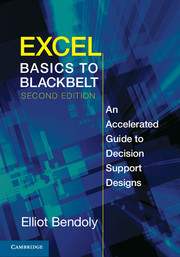Book contents
- Frontmatter
- Contents
- Associated Links
- Preface
- Section 1 Getting Oriented
- Section 2 Harvesting Intelligence
- 4 Structuring Problems and Option Visualization
- 5 Simplification Tactics
- 6 The Analytics of Optimization
- 7 Complex Optimization
- Section 3 Leveraging Dynamic Analysis
- Section 4 Advanced Automation and Interfacing
- Glossary of Key Terms
- Appendix: Shortcut (Hot Key) Reference
- Index
4 - Structuring Problems and Option Visualization
Published online by Cambridge University Press: 05 August 2013
- Frontmatter
- Contents
- Associated Links
- Preface
- Section 1 Getting Oriented
- Section 2 Harvesting Intelligence
- 4 Structuring Problems and Option Visualization
- 5 Simplification Tactics
- 6 The Analytics of Optimization
- 7 Complex Optimization
- Section 3 Leveraging Dynamic Analysis
- Section 4 Advanced Automation and Interfacing
- Glossary of Key Terms
- Appendix: Shortcut (Hot Key) Reference
- Index
Summary
Decision modeling describes the use of data and logic to clarify the specific nature of a situation for which assistance in the decision-making process may be needed. The hope is that in clarifying such details, the development of meaningful suggestions and solutions may be easier to create. Most management problems for which decisions are sought can be represented by three standard elements: objectives, decision variables, and cons-traints.
Objectives
Maximize profit
Provide earliest entry into market
Minimize employee discomfort and turnover
Decision variables
Determine what price to use
Determine the length of time tests should be run on a new product or service
Determine the responsibilities to assign to each worker
Constraints
Can't charge below cost
Must test enough to meet minimum safety regulations
Ensure responsibilities are shared by two workers at most
All of these elements can be visualized graphically, often to the benefit of analysis and general insights. Our initial discussion will be limited to objectives and decision variables; we'll discuss constraints further on in this chapter. In most business scenarios, managers are faced with making a set of decisions that impact a final outcome (objective). This tends to make the decision process more complex, and sometimes the rationale for making specific decisions is difficult to describe.
- Type
- Chapter
- Information
- Excel Basics to BlackbeltAn Accelerated Guide to Decision Support Designs, pp. 63 - 105Publisher: Cambridge University PressPrint publication year: 2013



